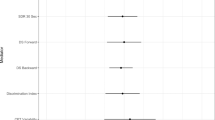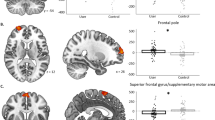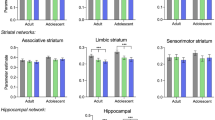Abstract
Cannabis is among the most frequently abused substances in the United States. Cognitive control is a contributory factor in the maintenance of substance-use disorders and may relate to treatment response. Therefore, we assessed whether cognitive-control-related neural activity before treatment differs between treatment-seeking cannabis-dependent and healthy individuals and relates to cannabis-abstinence measures during treatment and 1-year follow-up. Cannabis-dependent males (N=20) completed a functional magnetic resonance imaging (fMRI) cognitive-control (Stroop) task before a 12-week randomized controlled trial of cognitive–behavioral therapy and/or contingency management. A healthy-comparison group (N=20) also completed the fMRI task. Cannabis use was assessed by urine toxicology and self-report during treatment, and by self-report across a 1-year follow-up period (N=18). The cannabis-dependent group displayed diminished Stroop-related neural activity relative to the healthy-comparison group in multiple regions, including those strongly implicated in cognitive-control and addiction-related processes (eg, dorsolateral prefrontal cortex and ventral striatum). The groups did not differ significantly in response times (cannabis-dependent, N=12; healthy-comparison, N=14). Within the cannabis-dependent group, greater Stroop-related activity in regions including the dorsal anterior cingulate cortex was associated with less cannabis use during treatment. Greater activity in regions including the ventral striatum was associated with less cannabis use during 1-year posttreatment follow-up. These data suggest that lower cognitive-control-related neural activity in classic ‘control’ regions (eg, dorsolateral prefrontal cortex and dorsal anterior cingulate) and classic ‘salience/reward/learning’ regions (eg, ventral striatum) differentiates cannabis-dependent individuals from healthy individuals and relates to less abstinence within-treatment and during long-term follow-up. Clinically, results suggest that treatment development efforts that focus on enhancing cognitive control in addition to abstinence may improve treatment outcomes in cannabis dependence.
Similar content being viewed by others
Log in or create a free account to read this content
Gain free access to this article, as well as selected content from this journal and more on nature.com
or
References
APA (2013). Diagnostic and Statistical Manual of Mental Disorders—5th edn.
Battisti RA, Roodenrys S, Johnstone SJ, Pesa N, Hermens DF, Solowij N (2010). Chronic cannabis users show altered neurophysiological functioning on Stroop task conflict resolution. Psychopharmacology 212: 613–624.
Berkman ET, Falk EB, Lieberman MD (2011). In the trenches of real-world self-control: neural correlates of breaking the link between craving and smoking. Psychol Sci 22: 498–506.
Bhattacharyya S, Crippa JA, Allen P, Martin-Santos R, Borgwardt S, Fusar-Poli P et al (2012). Induction of psychosis by Delta9-tetrahydrocannabinol reflects modulation of prefrontal and striatal function during attentional salience processing. Arch Gen Psychiatry 69: 27–36.
Bolla K, Ernst M, Kiehl K, Mouratidis M, Eldreth D, Contoreggi C et al (2004). Prefrontal cortical dysfunction in abstinent cocaine abusers. J Neuropsychiatry Clin Neurosci 16: 456–464.
Brewer JA, Worhunsky PD, Carroll KM, Rounsaville BJ, Potenza MN (2008). Pretreatment brain activation during Stroop task is associated with outcomes in cocaine-dependent patients. Biol Psychiatry 64: 998–1004.
Budney AJ, Roffman R, Stephens RS, Walker D (2007). Marijuana dependence and its treatment. Addict Sci Clin Pract 4: 4–16.
Carpenter KM, Schreiber E, Church S, McDowell D (2006). Drug Stroop performance: relationships with primary substance of use and treatment outcome in a drug-dependent outpatient sample. Addict Behav 31: 174–181.
Carroll KM (1998) Therapy Manuals for Drug Addiction. A Cognitive-Behavioral Approach: Treating Cocaine Addiction. National Institute of Drug Abuse: Bethesda, MD, USA.
Carroll KM, Kiluk BD, Ball SA, Nich C (under review). Towards empirical identification of a valid, reliable and clinically meaningful indicator of treatment outcome for cocaine dependence.
Carroll KM, Kiluk BD, Nich C, Babuscio TA, Brewer JA, Potenza MN et al (2011). Cognitive function and treatment response in a randomized clinical trial of computer-based training in cognitive-behavioral therapy. Subst Use Misuse 46: 23–34.
Carroll KM, Kiluk BD, Nich C, DeVito EE, Decker S, Lapaglia D et al (2014). Toward empirical identification of a clinically meaningful indicator of treatment outcome: Features of candidate indicators and evaluation of sensitivity to treatment effects and relationship to one year follow up cocaine use outcomes. Drug Alcohol Depend 137C: 3–19.
Carroll KM, Nich C, Lapaglia DM, Peters EN, Easton CJ, Petry NM (2012). Combining cognitive behavioral therapy and contingency management to enhance their effects in treating cannabis dependence: less can be more, more or less. Addiction 107: 1650–1659.
Chung T, Geier C, Luna B, Pajtek S, Terwilliger R, Thatcher D et al (2011). Enhancing response inhibition by incentive: comparison of adolescents with and without substance use disorder. Drug Alcohol Depend 115: 43–50.
Connolly CG, Foxe JJ, Nierenberg J, Shpaner M, Garavan H (2012). The neurobiology of cognitive control in successful cocaine abstinence. Drug Alcohol Depend 121: 45–53.
Cousijn J, Goudriaan AE, Ridderinkhof KR, van den Brink W, Veltman DJ, Wiers RW (2012). Neural responses associated with cue-reactivity in frequent cannabis users. Addict Biol 18: 570–580.
DeVito EE, Worhunsky PD, Carroll KM, Rounsaville BJ, Kober H, Potenza MN (2012). A preliminary study of the neural effects of behavioral therapy for substance use disorders. Drug Alcohol Depend 122: 228–235.
Drummond C, Coulton S, James D, Godfrey C, Parrott S, Baxter J et al (2009). Effectiveness and cost-effectiveness of a stepped care intervention for alcohol use disorders in primary care: pilot study. Br J Psychiatry 195: 448–456.
Egner T, Hirsch J (2005). The neural correlates and functional integration of cognitive control in a Stroop task. Neuroimage 24: 539–547.
Eldreth DA, Matochik JA, Cadet JL, Bolla KI (2004). Abnormal brain activity in prefrontal brain regions in abstinent marijuana users. Neuroimage 23: 914–920.
Feldstein Ewing SW, McEachern AD, Yezhuvath U, Bryan AD, Hutchison KE, Filbey FM (2013). Integrating brain and behavior: evaluating adolescents' response to a cannabis intervention. Psychol Addict Behav 27: 510–525.
Filbey F, Yezhuvath U (2013). Functional connectivity in inhibitory control networks and severity of cannabis use disorder. Am J Drug Alcohol Abu 39: 382–391.
First MB, Spitzer RL, Gibbon M, Williams JB (1996) Structured Clinical Interview for DSM-IV Axis I Disorders—Patient Edition. Biometrics Research Department, New York State Psychiatric Institution: New York, NY, USA.
MTP Research Group (2004). Brief treatments for cannabis dependence: findings from a randomized multisite trial. J Consult Clin Psychol 72: 455–466.
Gruber SA, Rogowska J, Yurgelun-Todd DA (2009). Altered affective response in marijuana smokers: an FMRI study. Drug Alcohol Depend 105: 139–153.
Gruber SA, Yurgelun-Todd DA (2005). Neuroimaging of marijuana smokers during inhibitory processing: a pilot investigation. Brain Res Cogn Brain Res 23: 107–118.
Harding IH, Solowij N, Harrison BJ, Takagi M, Lorenzetti V, Lubman DI et al (2012). Functional connectivity in brain networks underlying cognitive control in chronic cannabis users. Neuropsychopharmacology 37: 1923–1933.
Hester R, Nestor L, Garavan H (2009). Impaired error awareness and anterior cingulate cortex hypoactivity in chronic cannabis users. Neuropsychopharmacology 34: 2450–2458.
Kober H, Mende-Siedlecki P, Kross EF, Weber J, Mischel W, Hart CL et al (2010). Prefrontal-striatal pathway underlies cognitive regulation of craving. Proc Natl Acad Sci USA 107: 14811–14816.
Lorenzetti V, Lubman DI, Whittle S, Solowij N, Yücel M (2010). Structural MRI findings in long-term cannabis users: what do we know? Subst Use Misuse 45: 1787–1808.
MacLeod CM (1991). Half a century of research on the Stroop effect: an integrative review. Psychol Bull 109: 163–203.
Martin-Santos R, Fagundo A, Crippa J, Atakan Z, Bhattacharyya S, Allen P et al (2010). Neuroimaging in cannabis use: a systematic review of the literature. Psychol Med 40: 383–398.
Miller EK, Cohen JD (2001). An integrative theory of prefrontal cortex function. Annu Rev Neurosci 24: 167–202.
Moeller SJ, Tomasi D, Woicik PA, Maloney T, Alia-Klein N, Honorio J et al (2012). Enhanced midbrain response at 6-month follow-up in cocaine addiction, association with reduced drug-related choice. Addict Biol 17: 1013–1025.
Nestor L, McCabe E, Jones J, Clancy L, Garavan H (2011). Differences in ‘bottom-up’ and ‘top-down’ neural activity in current and former cigarette smokers: Evidence for neural substrates which may promote nicotine abstinence through increased cognitive control. Neuroimage 56: 2258–2275.
Peters EN, Nich C, Carroll KM (2011). Primary outcomes in two randomized controlled trials of treatments for cannabis use disorders. Drug Alcohol Depend 118: 408–416.
Peterson BS, Skudlarski P, Gatenby JC, Zhang H, Anderson AW, Gore JC (1999). An fMRI study of Stroop word-color interference: evidence for cingulate subregions subserving multiple distributed attentional systems. Biol Psychiatry 45: 1237–1258.
Potenza MN, Sofuoglu M, Carroll KM, Rounsaville BJ (2011). Neuroscience of behavioral and pharmacological treatments for addictions. Neuron 69: 695–712.
Robinson SM, Sobell LC, Sobell MB, Leo GI (2012). Reliability of the timeline followback for cocaine, cannabis, and cigarette use. Psychol Addict Behav 1–9.
SAMHSA (2011). Substance Abuse and Mental Health Services Administration. Results from the 2010 National Survey on Drug Use and Health: Summary of National Findings.
Schreiner AM, Dunn ME (2012). Residual effects of cannabis use on neurocognitive performance after prolonged abstinence: a meta-analysis. Exp Clin Psychopharmacol 20: 420–429.
Smith D, Jones P, Bullmore E, Robbins T, Ersche K (2013). Cognitive control dysfunction and abnormal frontal cortex activation in stimulant drug users and their biological siblings. Transl Psychiatry 3: 1–9.
Sobell LC, Sobell MB (1992). Timeline follow-back: a technique for assessing self-reported alcohol consumption. In: Litten RZ, Allen J, (eds) Measuring Alcohol Consumption: Psychosocial and Biochemical Methods. Humana Press: Totowa, NJ, USA. pp 41–72.
Solowij N, Stephens RS, Roffman RA, Babor T, Kadden R, Miller M et al (2002). Cognitive functioning of long-term heavy cannabis users seeking treatment. JAMA 287: 1123–1131.
Stanger C, Elton A, Ryan SR, James GA, Budney AJ, Kilts CD (2013). Neuroeconomics and adolescent substance abuse: individual differences in neural networks and delay discounting. J Am Acad Child Adolesc Psychiatry 52: 747–755.
Stanger C, Ryan SR, Fu H, Landes RD, Jones BA, Bickel WK et al (2012). Delay discounting predicts adolescent substance abuse treatment outcome. Exp Clin Psychopharmacol 20: 205–212.
Streeter CC, Terhune DB, Whitfield TH, Gruber S, Sarid-Segal O, Silveri MM et al (2008). Performance on the Stroop predicts treatment compliance in cocaine-dependent individuals. Neuropsychopharmacology 33: 827–836.
Takagi M, Lubman DI, Cotton S, Fornito A, Baliz Y, Tucker A et al (2011). Executive control among adolescent inhalant and cannabis users. Drug Alcohol Rev 30: 629–637.
van Hell HH, Vink M, Ossewaarde L, Jager G, Kahn RS, Ramsey NF (2010). Chronic effects of cannabis use on the human reward system: an fMRI study. Eur Neuropsychopharmacol 20: 153–163.
Wager TD, Keller MC, Lacey SC, Jonides J (2005). Increased sensitivity in neuroimaging analyses using robust regression. Neuroimage 26: 99–113.
Wesley MJ, Hanlon CA, Porrino LJ (2011). Poor decision-making by chronic marijuana users is associated with decreased functional responsiveness to negative consequences. Psychiatry Res 191: 51–59.
Zachary RA (1991) The Manual of the Shipley Institute of Living Scale-Revised. Western Psychological Services: LA, USA.
Acknowledgements
We would like to thank Charla Nich and Karen Hunkele for their valuable contribution to data management, particularly with the preparation of the clinical variables; Dan Marino, Scott Bullock, and Monica Solorzano for their subject recruitment and neuroimaging data collection; Maggie Mae Mell and Jiansong Xu for their assistance with the Stroop behavioral data; and Joanne Corvino and Iris Balodis for their help with managing recruitment efforts. We also thank all the participants for their time.
Author information
Authors and Affiliations
Corresponding author
Additional information
Supplementary Information accompanies the paper on the Neuropsychopharmacology website
Supplementary information
Rights and permissions
About this article
Cite this article
Kober, H., DeVito, E., DeLeone, C. et al. Cannabis Abstinence During Treatment and One-Year Follow-Up: Relationship to Neural Activity in Men. Neuropsychopharmacol 39, 2288–2298 (2014). https://doi.org/10.1038/npp.2014.82
Received:
Revised:
Accepted:
Published:
Issue date:
DOI: https://doi.org/10.1038/npp.2014.82
This article is cited by
-
Context dependent differences in working memory related brain activity in heavy cannabis users
Psychopharmacology (2022)
-
Interaction of schizophrenia and chronic cannabis use on reward anticipation sensitivity
npj Schizophrenia (2021)
-
Attenuated reward activations associated with cannabis use in anxious/depressed individuals
Translational Psychiatry (2020)



